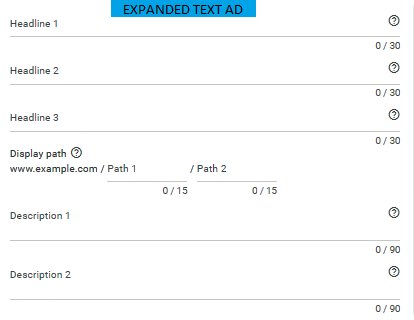Responsive search is one of the two ad formats Google launched under "Responsive ad formats." Since Responsive display ads is a default ad type for the Display Network, we will cover only the types of Search ads and talk about the difference between Responsive search ads and expanded text ads in Google Ads. With RSA being a relatively new ad format, we will try to answer what makes RSA different from Google ETA and if creating RSA is more than a trend that many marketers follow.
Expanded text ads
Text ads used to have two headlines and one description. By expanding headline and description space (by one each), the new, improved format rightfully deserved the prefix "expanded" added to its name.

Since the third headline and second description fields are considered optional fields, they can show only when there is enough space. That said, you should be thinking about having critical points noted in the first two headlines and description one when writing an ad.
Responsive search ads
The main thing about Responsive search ads is that they give you the ability to write a ton of description, and almost four times more headlines.

Multiple headlines = Up to 15
Multiple descriptions = Up to 4 descriptions
Google automatically assembles search text ads that unfolds the best combination.
The idea behind this newer type of ad is that Google's machine learning and automation test different combinations to identify which combinations drive excellent results. The best mixture of headlines and descriptions should, as a consequence, have a boost in CTR, improve Quality Score, and lower CPC.
The assumption is that with Responsive Search Ads, Google does most of that challenging work in generating the best performing ads, working with assets that an advertiser created and uploaded previously.
Before Responsive search ads came into the picture, if an advertiser wanted to test multiple combinations of search ads, it would have to manually create various iterations of search ads and monitor the performance to see which combination will generate the most beneficial results.
The benefit here is that, by leveraging machine learning, RSA saves you some time you would otherwise spend in creating all possible combinations for testing and closely monitoring ad performance yourself.
If you are already using Google RSA, measure if the time saved is coupled with enhanced results.
Invest time in crafting RSA.
The text ads area is very creative and requires high copywriting skills. Above all, it demands you to know your target customer. This applies to both Search ad formats, as you are the one who comes up with the ad wording for RSA and ETA, not Google.
The thing with RSA is that you have to be careful about what you put into your headlines and descriptions. Any ad at a given time can consist of any (up to) three different headlines and (up to) two descriptions. Knowing that assets you feed the algorithm to show in any order requires much more thought to create an RSA than one would initially assume.
The chances are that Google won't display your entire ad, just like with ETA. So if you have a copy that should appear in every ad, you need to add that text to either headline position 1, headline position 2, or description position 1.
Explore the pinning feature.
Google has introduced a possibility of pinning a text into an individual headline or description that causes it to display only in that precise position, which, as a result, prevents other headlines or descriptions from showing in its place.
Since the first two headlines and the first description will always show, you will prevent the unpinned text from showing and reduce the overall number of headlines or descriptions that can match a potential customer's search by pinning all of them.
This feature had left us wondering what's the point of RSA when you can lock in some text to show at all times? Maybe Google wants to provide that feeling of maintaining control to marketers.
And perhaps this pinning can be justified by setting the most crucial part of your message to show always, so you don't repeat it in other headlines/descriptions, since RSA's practice recommendations are to create unique texts that don't reproduce the same or even similar phrases.
Final thoughts about combining RSA and ETA.
Responsive search ads are intended to split test distinct features and benefits based on various trigger search queries.
Split testing ad copy is an integral part of the optimization process.
When waging on RSA's success, savvy paid search analysts use the aspect of RSA's role in optimizing existing ETAs. Since responsive ads help widen the audience by matching those queries that might not best fit your regular copy in ETA, this means that they open extra ad inventory and unlock more auctions. In that sense, Google RSA can be an excellent addition to your Google ETA.
RSAs are most likely to make your ads reach a wider audience and, consequently, get more impressions but won't, in many cases, result in high CTR. If you see RSA performing far worse than ETA, weigh the added volume's gains against the lower performance to determine if it's worth to keep running them.

